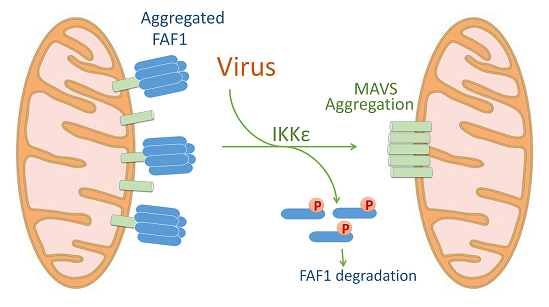On November 21, 2018, Professor Long Zhang’s group published a research paper on Cell Host & Microbe entitled "FAF1 regulates antiviral immunity by inhibiting MAVS but is antagonized by phosphorylation upon viral infection". This article revealed how MAVS aggregation is antagonized by another aggregated protein and also the first report describing that FAF1 is an aggregated protein that could be directly regulated by IKKε via site specific phosphorylation and interrelated acetylation.
Innate immunity plays a crucial role in the defence against pathogen invasion, and precise regulation of innate immunity is required to eliminate infections and avoid harmful immune-pathology. Upon interacting with RIG-I, MAVS undergoes Lysine 63-linked poly-ubiquitination by the E3 ligase TRIM31 and subsequently aggregates to activate downstream signaling effectors. The prion-like self-aggregation of MAVS at the mitochondria was shown to be induced by virus and critical for the amplification of innate antiviral response. However, the mechanism that prevents MAVS from self-activation remains elusive. This group find that the scaffold protein FAF1 forms aggregates that negatively regulate MAVS. FAF1 antagonizes the poly-ubiquitination and aggregation of MAVS by competing with TRIM31 for MAVS association. FAF1 knock-out mice are more resistant to RNA virus infection and FAF1 deficiency in myeloid cells results in enhanced innate signaling and reduced viral load and morbidity in vivo. Upon virus infection, the kinase IKKε directly phosphorylates FAF1 at Ser556 and triggers FAF1 de-aggregation. Moreover, Ser556 phosphorylation promotes FAF1 lysosomal degradation, consequently relieving FAF1-dependent suppression of MAVS. These findings establish FAF1 as a modulator of MAVS and uncover mechanisms that regulate FAF1 to insure timely activation of antiviral defense.

Working model of FAF1 in regulating and is regulated by the innate antiviral immunity.
This work was supported by the special program from Ministry of Science and Technology of China (2016YFA0502500 to L. Z.), the Chinese National Natural Science Funds (31741086, 91753139, 31471315 and 31671457 to L.Z., 31871405, 31571460 to F.Z., 31870902 to S.W., 31701232 to F.X.), the Jiangsu National Science Foundation (BK20150354, BK20180043 to F. Z.) and the Postgraduate Research & Practice Innovation Program of Jiangsu Province (KYCX18_2524 to T. D).
Links:https://www.cell.com/cell-host-microbe/fulltext/S1931-3128(18)30544-4



